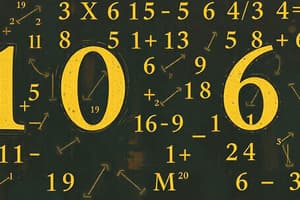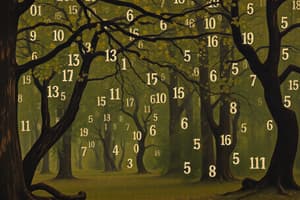Podcast
Questions and Answers
Which property is demonstrated by the equation $5 \times (2 + 3) = (5 \times 2) + (5 \times 3)$?
Which property is demonstrated by the equation $5 \times (2 + 3) = (5 \times 2) + (5 \times 3)$?
- Identity Property
- Commutative Property
- Associative Property
- Distributive Property (correct)
What is the result of $\frac{5}{8} \div \frac{3}{4}$?
What is the result of $\frac{5}{8} \div \frac{3}{4}$?
- $\frac{15}{32}$
- $\frac{5}{6}$ (correct)
- $\frac{15}{24}$
- $\frac{20}{24}$
What is 35% of 80?
What is 35% of 80?
- 30
- 20
- 28 (correct)
- 32
Which of the following numbers is NOT a rational number?
Which of the following numbers is NOT a rational number?
What is the value of the expression $2 \times (5 + 3) - 4 \div 2$?
What is the value of the expression $2 \times (5 + 3) - 4 \div 2$?
Which of these numbers is divisible by 3?
Which of these numbers is divisible by 3?
What is the greatest common divisor (GCD) of 24 and 36?
What is the greatest common divisor (GCD) of 24 and 36?
Simplify the ratio 24:40 into its simplest form.
Simplify the ratio 24:40 into its simplest form.
What is the additive inverse of -7?
What is the additive inverse of -7?
Evaluate $|-8| + |3 - 5|$
Evaluate $|-8| + |3 - 5|$
Flashcards
Addition
Addition
Combining numbers to find their total value.
Subtraction
Subtraction
Finding the difference between two numbers.
Multiplication
Multiplication
Repeated addition of the same number.
Division
Division
Signup and view all the flashcards
Rational Numbers
Rational Numbers
Signup and view all the flashcards
Commutative Property
Commutative Property
Signup and view all the flashcards
Order of Operations
Order of Operations
Signup and view all the flashcards
Fraction
Fraction
Signup and view all the flashcards
Absolute Value
Absolute Value
Signup and view all the flashcards
Prime Numbers
Prime Numbers
Signup and view all the flashcards
Study Notes
Arithmetic is a branch of mathematics focused on numbers and their basic operations.
- Arithmetic provides a foundation for advanced mathematics.
- Key operations include addition, subtraction, multiplication and division.
Basic Operations
- Addition combines numbers to find a total, using symbol "+".
- Subtraction finds the difference between numbers, using symbol "-".
- Multiplication is repeated addition, using symbol "×" or "*".
- Division splits a number into equal parts, using symbol "÷" or "/".
Numbers
- Natural numbers: positive integers starting from 1 (1, 2, 3,...).
- Whole numbers: natural numbers including zero (0, 1, 2, 3,...).
- Integers: positive and negative whole numbers (... -2, -1, 0, 1, 2,...).
- Rational numbers: expressible as a fraction p/q, where p and q are integers and q ≠ 0.
- Irrational numbers: cannot be expressed as a fraction and have non-repeating, non-terminating decimal expansions (e.g., √2, π).
- Real numbers: include all rational and irrational numbers.
Properties of Operations
- Commutative property: order doesn't affect result in addition/multiplication (a + b = b + a, a × b = b × a).
- Associative property: grouping doesn't affect result in addition/multiplication ((a + b) + c = a + (b + c), (a × b) × c = a × (b × c)).
- Distributive property: multiplication distributes over addition (a × (b + c) = a × b + a × c).
- Identity property: adding 0 doesn't change a number (a + 0 = a), multiplying by 1 doesn't change a number (a × 1 = a).
- Inverse property: For any number a, a + (-a) = 0 (additive inverse); for any non-zero a, a × (1/a) = 1 (multiplicative inverse).
Order of Operations
- Operations should be performed in a specific sequence.
- PEMDAS/BODMAS: Parentheses/Brackets, Exponents/Orders, Multiplication and Division (left to right), Addition and Subtraction (left to right).
Fractions
- Represents a part of a whole, written as p/q (numerator/denominator).
- Equivalent fractions: same value, different numerator and denominator (e.g., 1/2 = 2/4 = 3/6).
- Add/subtract fractions: must have a common denominator.
- Multiply fractions: multiply numerators and denominators separately (a/b × c/d = (a × c) / (b × d)).
- Divide fractions: multiply by the reciprocal of the divisor (a/b ÷ c/d = a/b × d/c = (a × d) / (b × c)).
Decimals
- Represent fractions with a base of 10.
- Digits to the right of the decimal point represent fractions with a denominator that is a power of 10 (e.g., 0.1 = 1/10, 0.01 = 1/100).
- Add/subtract decimals: align decimal points.
- Multiply decimals: multiply as whole numbers, then place the decimal point (number of decimal places equals the sum of the decimal places in the factors).
- Divide decimals: make the divisor a whole number (multiply both divisor and dividend by the same power of 10).
Percentages
- Way of expressing a number as a fraction of 100, using symbol "%".
- Convert fraction to percentage: multiply by 100 (e.g., 1/2 = 0.5 × 100 = 50%).
- Convert percentage to fraction: divide by 100 (e.g., 75% = 75/100 = 3/4).
- Find a percentage of a number: multiply the number by the percentage expressed as a decimal (e.g., 20% of 50 = 0.20 × 50 = 10).
Ratios and Proportions
- Ratio: a comparison of two or more quantities, written as a:b or a/b.
- Proportion: equation stating two ratios are equal (a/b = c/d).
- In a proportion, cross products are equal (a × d = b × c).
Powers and Roots
- Power: represents repeated multiplication of a number by itself, written as a^n (a is the base, n is the exponent).
- Root: the inverse operation of a power.
- The nth root of a number a is written as n√a.
- Square root (√a): the root when n=2.
Divisibility Rules
- Divisibility rules: shortcuts to determine if a number is divisible by another without division.
- Divisible by 2: last digit is even.
- Divisible by 3: sum of digits is divisible by 3.
- Divisible by 4: number formed by last two digits is divisible by 4.
- Divisible by 5: last digit is 0 or 5.
- Divisible by 6: divisible by both 2 and 3.
- Divisible by 9: sum of digits is divisible by 9.
- Divisible by 10: last digit is 0.
Prime Numbers and Composite Numbers
- Prime number: natural number greater than 1 with only two positive divisors: 1 and itself (e.g., 2, 3, 5, 7, 11).
- Composite number: natural number greater than 1 with more than two positive divisors (e.g., 4, 6, 8, 9, 10).
- The number 1 is neither prime nor composite.
Greatest Common Divisor (GCD) and Least Common Multiple (LCM)
- GCD: largest number that divides evenly into all numbers.
- LCM: smallest number that is a multiple of all numbers.
Absolute Value
- Distance from zero on the number line, written as |a|.
- Absolute value of a positive number: the number itself (|5| = 5).
- Absolute value of a negative number: the opposite of the number (|-5| = 5).
- Absolute value of zero: zero (|0| = 0).
Studying That Suits You
Use AI to generate personalized quizzes and flashcards to suit your learning preferences.




